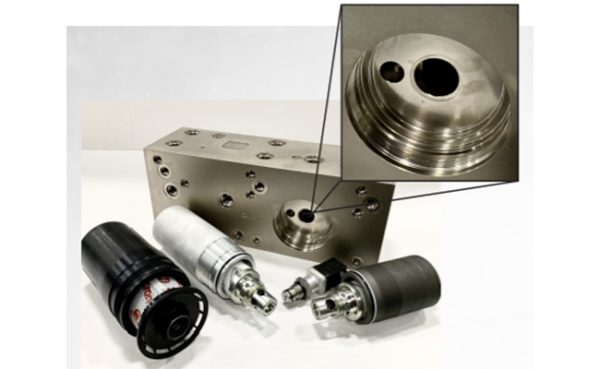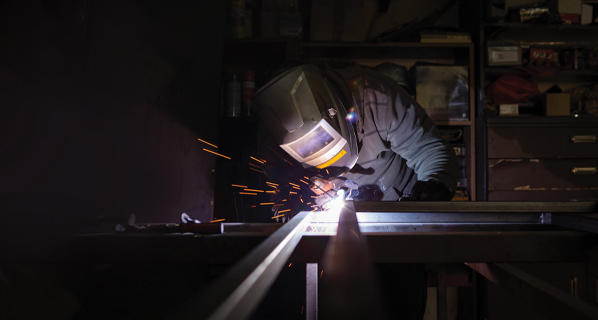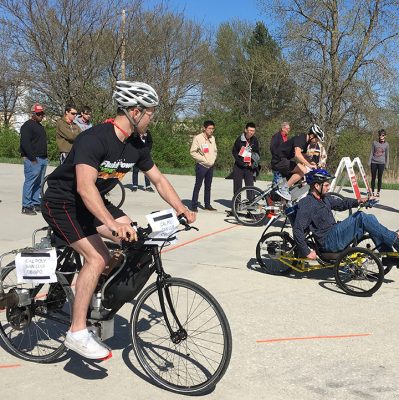Test Your Skills: Hydrostatic Transmissions
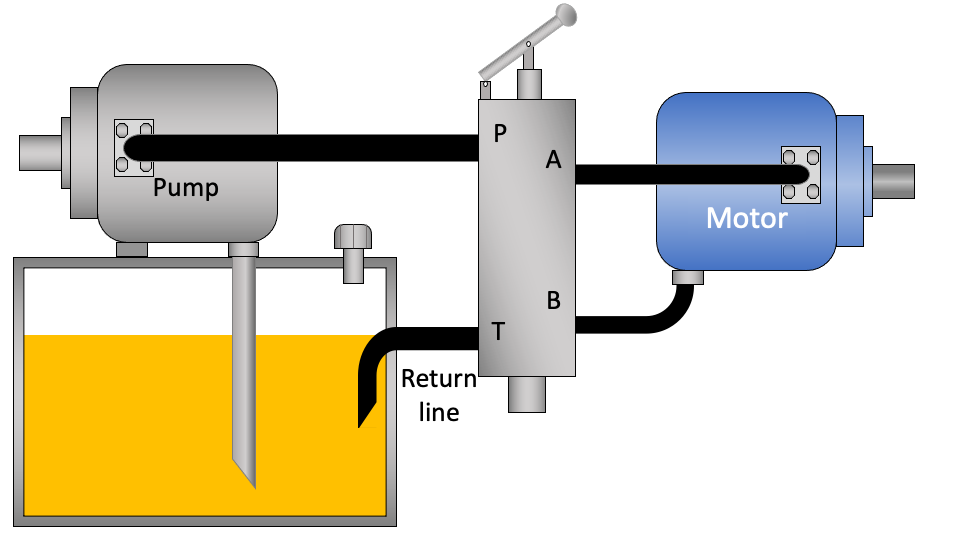
The transmission of force through a contained hydraulic fluid (hydrostatics) will fall into one of two categories: open circuit or closed circuit.
An open circuit is simply one where a pump receives fluid from the reservoir and delivers power to an actuator with the actuator returning the fluid to the reservoir. This is the most common type of circuit and usually requires some directional control as well as some overpressure protection. The directional valve allows the motor to be driven in either direction, even though the pump is only rotating in one direction. An advantage of the open circuit is that a single pump can supply flow to multiple actuators, both linear and rotary (cylinders and motors).

Closed Loop
A closed circuit is where a pump provides flow to an actuator (usually a motor) without the use of directional valves. The working fluid that is transmitting power is contained between the pump and the motor, and so the system is called a hydrostatic transmission. The ports of the pump are connected directly to the ports of the motor so that the flow from the pump drives the motor, and the discharge from the motor feeds the inlet to the pump. There may be additional valves that are included in the transmission package, but the main flow paths are between the pump and the motor. If the pump has an overcenter swashplate, the position of the swashplate determines which line is pressurized, along with the direction and speed of the motor.
The pump and motor may be combined in a common housing or connected by plumbing when the motor is at some distance from the pump. The transmission produces a speed-torque ratio equal to the ratio of the motor and pump displacements. The motor can be a high speed/low torque, or a low speed/high torque design. Fixed or variable displacement pumps and motors can be used to match the need of the application.
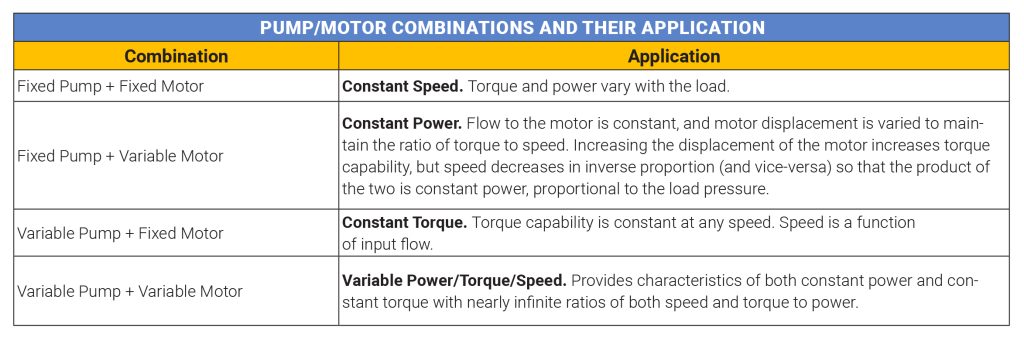 There are several pump/motor arrangements (see figure 1) that are possible for a hydrostatic transmission, either as attached or separated.
There are several pump/motor arrangements (see figure 1) that are possible for a hydrostatic transmission, either as attached or separated.

Figure 1.
Either working line may be pressurized, and so there are case drains on the pump and motor to prevent overpressurizing the respective cases. To resupply the drained fluid, a replenishing pump (charge pump) is added to the circuit to prevent cavitation, supply cooling flow, and provide pressure for actuating a control servo. The charge pump maintains a constant supply of fluid to the working lines at a pressure that is typically between 1.4 and 2.8 MPa (200 and 400 psi) and is set by the charge relief. Check valves are arranged so that the line with flow returning from the motor (the lower pressure line) will receive the make-up fluid.
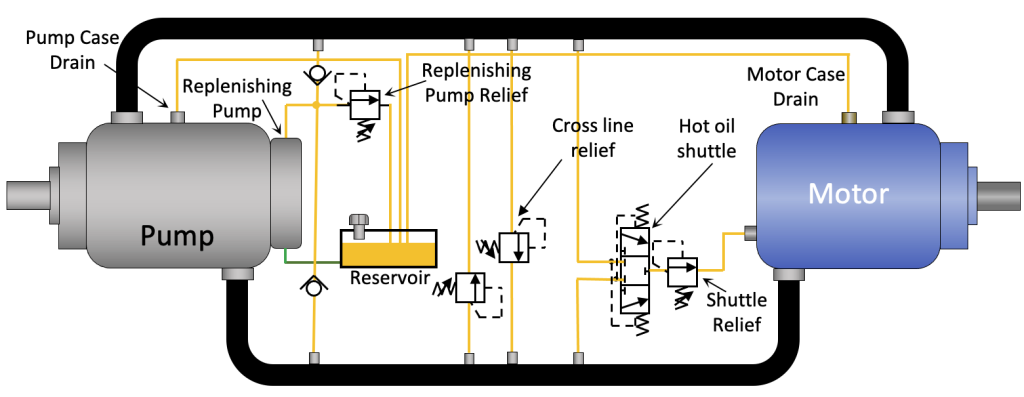
Figure 2.
Cooling fluid is supplied by way of a shuttle valve, often called a hot oil shuttle. This valve directs flow from the lower pressure working line to a flushing port on the pump and/or motor. This valve is illustrated in figure 2. The line with the higher pressure shifts the valve to direct low-pressure cooling fluid to exit port 3 and is typically directed over a shuttle relief valve set at some value below the setting of the charge pump relief valve. This ensures that all the charge pump flow is directed into the transmission loop on the low-pressure side. The exit flow from the shuttle relief may be directed directly to tank or through the case of the pump and/or motor and then to tank.
Cross-line relief valves may be included to prevent overpressure in the working lines. The fluid is relieved to the opposite (low-pressure) line. These relief valves provide for the dynamic braking of the motor.
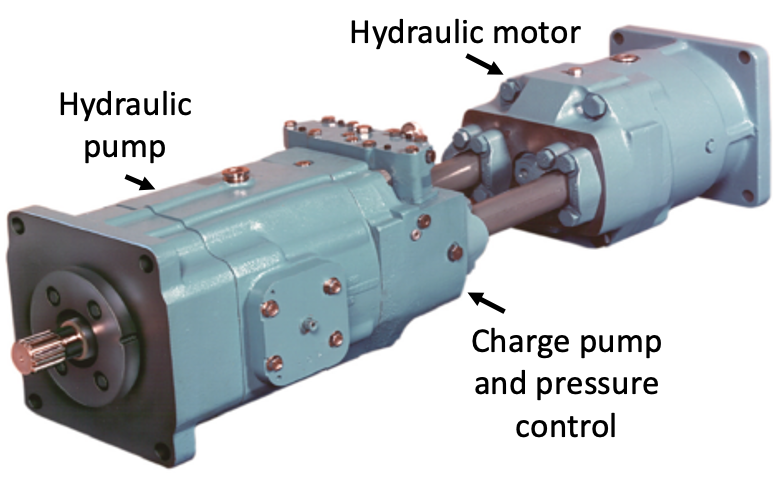
Figure 3.
Figure 2 illustrates the arrangement of the replenishing (charge) pump and additional valves that are often found on a hydrostatic transmission. These components may be piped in externally but are more often contained within the body of the pump and/or motor as illustrated in figure 3.
Test Your Skills
1. An advantage of an open circuit in a hydraulic system is that:
a. Multiple motors can be used to drive a single pump.
b. The reservoirs will always be very small.
c. A single pump can supply flow to multiple actuators.
d. A single pump always drives only one motor or cylinder.
e. The pressure is no longer dependent on the load.
2. The replenishing pump (charge pump) is used to:
a. Provide makeup fluid because of the case drains.
b. Provide cooling fluid to the pump and/or motor.
c. Prevent overpressurizing the respective cases.
d. Provide pilot pressure for actuating a control servo.
e. Answers a, b, and d.
3. The hot oil shuttle valve:
a. Senses the temperature of the fluid and directs hot oil to the heat exchanger.
b. Directs the case drain fluid back into the pump inlet.
c. Directs high-pressure cooling fluid to the case of the pump and/or motor.
d. Directs flow from the lower pressure working line to flush the pump and/or motor.
e. Is used to prevent overpressure.
See the Solutions
1-c, 2-e, and 3-c


